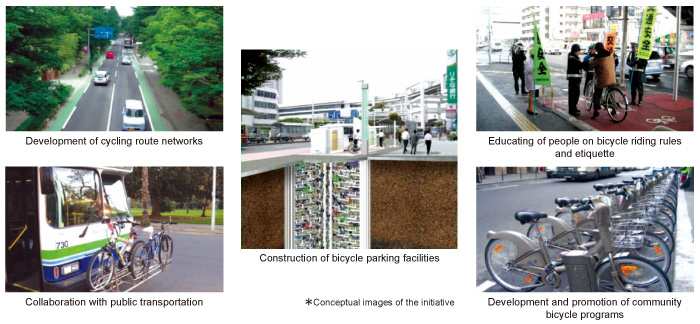
History of Traffic Safety Measures: Relevant Legislation, Organization and Policy (PDF)

New Approaches to Reduce Road Traffic Accidents in Japan (PDF)
Safety
1. Reducing traffic accidents
The number of traffic fatalities has decreased for 12 consecutive years, fell below 4,500 in 2012, but the number of traffic fatalities and injuries still exceeds 800,000. In particular, the ratios of senior citizen and pedestrian fatalities are higher than in Europe and the United States. Therefore, effective and efficient measures are being implemented to reduce traffic accidents on both arterial roads and community roads.
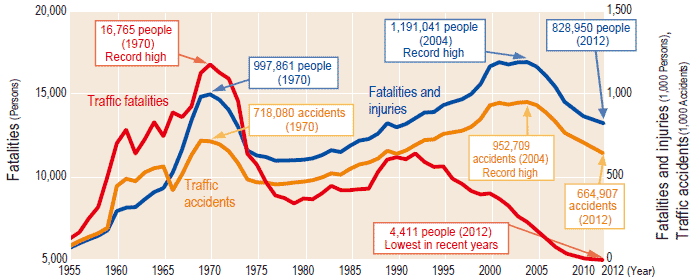
* 1. Up until 1959, accidents causing minor injuries (injuries treat able in less than eight days and property damage less than 20,000 yen) were not included.
* 2. In and after 1966, the number of accidents does not include property damage.
* 3. In and before 1971, Okinawa Prefecture is not included in th e numbers of accidents, fatalities and injuries.
Source: Data from the National Police Agency
Traffic accident measures on arterial roads
Because traffic accidents frequently occur in specific sections of arterial roads, 3,396 sections with a particularly high incidence of high accident sections. Intensive measures for death or injury accidents were designated as these sections are being conducted through the collaboration of prefectural Public Safety Commissions and road administrators.
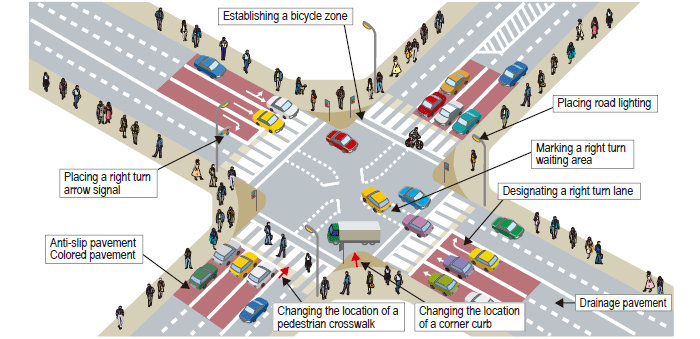
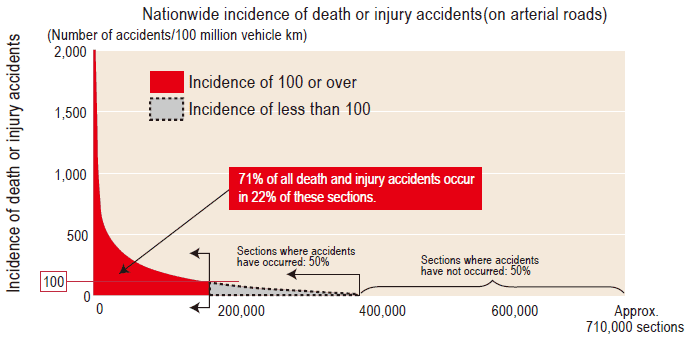
* Created from data on averages of accidents
that occurred during four years (2003-2006)
on approximately 180,000 km of national and
prefectural roads throughout Japan.
After sorting the sections in descending order according to the incidence of death or injury accidents, those which require priority implementation of measures are selected and specified as priority action sections.
Traffic accident measures for community roads
Meticulous traffic accident measures are being conducted for community roads by establishing a problem solving cycle from problem identification and sorting to confirmation of project implementation benefits through collaboration with regional residents and related organizations.
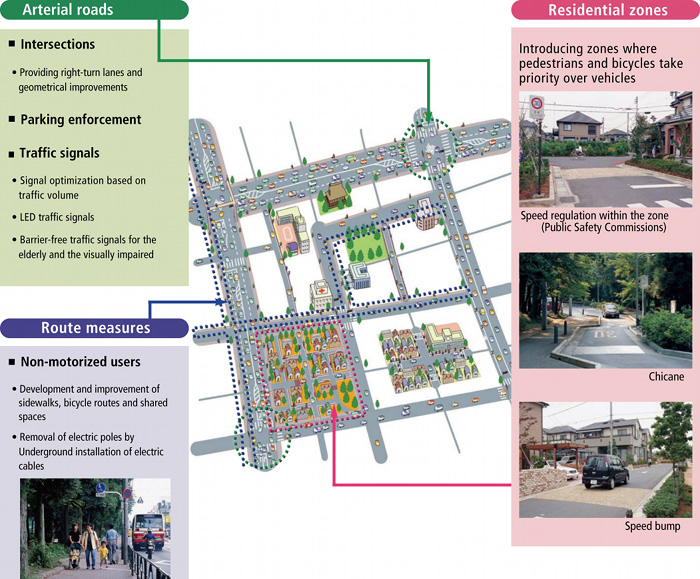
A survey on the road traffic situation at roughly 36,000 railroad crossings all over Japan was conducted in 2006 and revealed that about 1,800 crossings urgently need measures for easing traffic congestion. Comprehensive and focused measures are being carried out on the crossings by combining immediate measures, such as widening pedestrian paths, and drastic measures, such as the implementation of grade separation.

The continuous grade separation project promotes integration of divided cities and smoothes
urban traffic flow by eliminating many crossings through the use of elevated or underground
railways at road-rail intersections.
2. Creating a Comfortable Living Environment
Road construction and improvement projects are being implemented so that people can truly experience the improvements, such as safe and comfortable pedestrian spaces; high-quality living environments with roadside greening; running utility cables underground, etc.
Promoting universal design in pedestrian spaces
By 2012, barrier-free pedestrian paths will be increased to represent about 75% of all road segments interconnecting railway stations, government facilities, hospitals and the like, which are designated by the Minister of Land, Infrastructure, Transport and Tourism as road sections where a large number of elderly and disabled people normally travel on foot.

Eliminating utility poles
Utility poles are being eliminated to help secure safe and
comfortable pedestrian spaces; create a visually enhanced
landscape and living environment; prevent disasters; improve
the reliability of telecommunications networks conserve historical
townscapes; promote tourism, restore local culture; and
revitalize local communities.
We will continue to promote the elimination of utility poles in
the future by aggressively utilizing multiple methods that suit
local situations such as a combined approach of widening
roads projects in conjunction with the elimination of utility poles
and wiring in spaces under or behind building eaves. We will
additionally look to reduce costs.
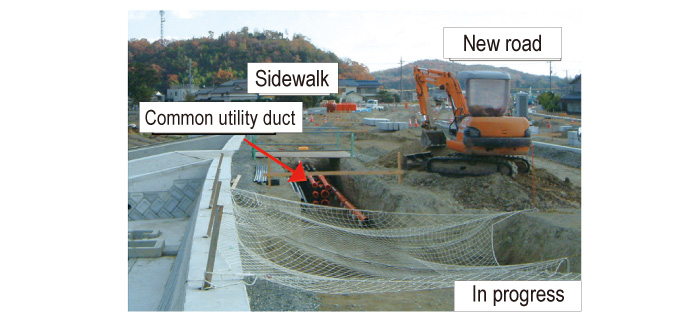
Identical installation of common utility duct
simultaneous with road construction project
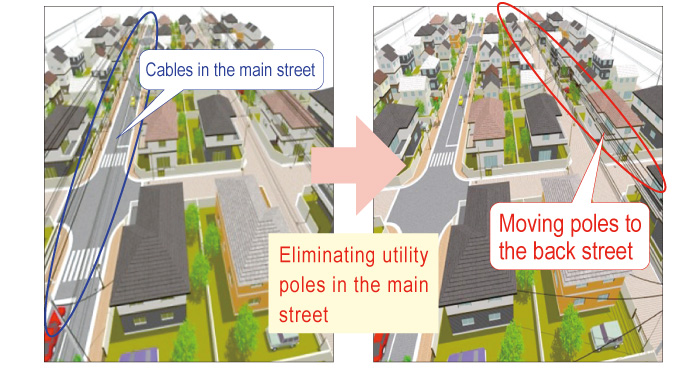
Moving cables to the side street behind the
street where poles are to be eliminated
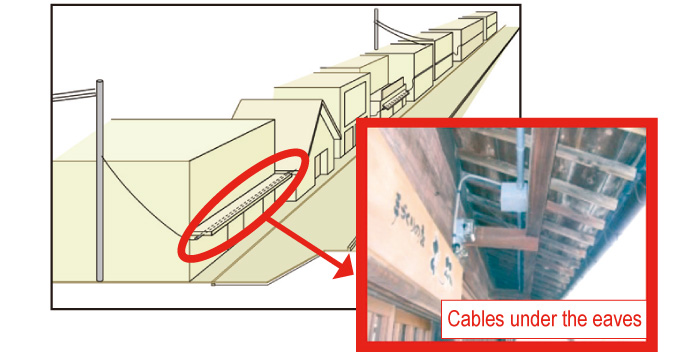
Running cables under/along the eaves
of houses along the street

3. Creating a safe and pleasant environment for bicycle riding
While bicycles play an important role in the urban transportation
system as a convenient transportation method, infrastructure
for cyclists is not yet sufficient and is resulting in an
increase of bicycle accidents relative to the total number of
traffic accidents.
To stop this trend, MLIT and the National Police Agency
(NPA) cooperated to launch the “Committee for Creating a
Safe & Comfortable Bicycle-Use Environment” in 2011. The
Committee submitted the following proposal to MLIT and the
NPA: “A Bicycle Environment that is Friendly to Everybody:
Proposal for a Safe & Comfortable Bicycle-Use Environment.”
In response to the proposal, in November 2012, MLIT and the
NPA jointly formulated, “Guideline for Creating a Safe &
Comfortable Bicycle-Use Environment.”
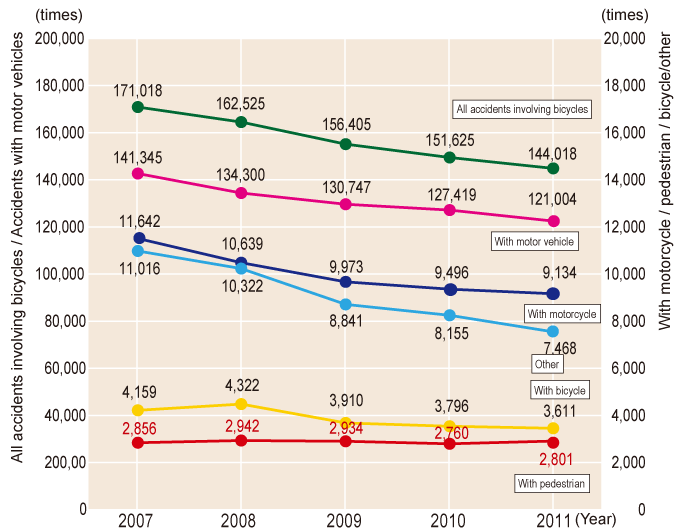
Note: "Accidents involving bicycles" means the first party or the second party is a bicyclist and
accidents between two or more bicyclists are calculated as one instance.
Source: Information from National Police Agency
